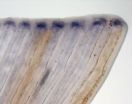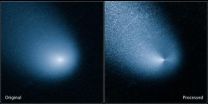(Press-News.org) This news release is available in German.
The material class of topological insulators has been discovered a few years ago and displays amazing properties: In their inside, they behave electrically insulating but at their surface they form metallic, conducting states. The electron spin, i. e., their intrinsic angular momentum, is playing a decisive role. Their sense of rotation is directly coupled to their direction of movement. This coupling leads not only to a high stability of the metallic property but also enables a particularly lossless electrical conduction. Topological insulators are, therefore, considered interesting and promising candidates for novel devices in information technology.
A particularly innovative approach is to try and influence the electron spin at the surface in such devices by light. HZB researcher Prof. Oliver Rader and his team have discovered by which means the spin at the surface of topological insulators can be altered. To this end, the researches performed experiments with light of various energies or wavelengths.
The wavelenght counts
At the synchrotron radiation source BESSY II they investigated the topological insulator bismuth selenide (Bi2Se3) using a method called "spin-resolved photoelectron spectroscopy" – and gained astonishing insights: They found an astonishing difference depending on whether the electrons at the surface of the material are excited with circularly polarized light in the vacuum ultraviolet (50-70 electron volts, eV) or in the ultraviolet spectral range (6 eV). They could demonstrate that they can measure the spin of the electrons without changing it at higher energies which are typically used at synchtrotron light sources. "When excited at 50 eV, the emitted electros display the typical spin texture of topological insulators", Dr. Jaime Sánchez-Barriga, who conducted the experiments, explains. "The electron spins are in the surface aligned on a circle, similarly to a traffic sign for roundabout." This is the ground state of the electrons in the surface of topological insulators."
When excited by low-energy circularly polarized photons (6 eV), the spin of the electrons moved completely out of the surface plane. Above all, they adopted the spin orientation imposed by the right- or left-circularly polarized light. This means that the spin can be systematically manipulated – depending on the light that is used. The scientists can also explain the entirely different behavior at different energies which they attribute to symmetry properties. "Our result delivers important insight how lossless currents could be induced in topological insulators", Oliver Rader explains. "This is important for the development of so-called optospintronic devices which could enormously enhance the speed at which information is stored and processed."
DFG Priority Program
Due to the high potential promised by topological insulators, the German Research Foundation DFG initiated the Priority Program „Topological Insulators: Materials – Fundamental Properties – Devices". Prof. Rader coordinates this program which aims at an improved understanding of the physics of the surface states in topological insulators.
INFORMATION:
Publication: Photoemission of Bi2Se3 with Circularly Polarized Light: Probe of Spin Polarization or Means for Spin Manipulation? Phys. Rev. X 4, 011046 – Published 24 March 2014; J. Sánchez-Barriga, A. Varykhalov, J. Braun, S.-Y. Xu, N. Alidoust, O. Kornilov, J. Minár, K. Hummer, G. Springholz, G. Bauer, R. Schumann, L. V. Yashina, H. Ebert, M. Z. Hasan, and O. Rader.
Controlling electron spins by light
Researchers of HZB manipulate the electron spin at the surface of topological insulators systematically by light
2014-03-27
ELSE PRESS RELEASES FROM THIS DATE:
To grow or not to grow: a step forward in adult vertebrate tissue regeneration
2014-03-27
The reason why some animals can regenerate tissues after severe organ loss or amputation while others, such as humans, cannot renew some structures has always intrigued scientists. In a study now published in PLOS ONE*, a research group from Instituto Gulbenkian de Ciência (IGC, Portugal) led by Joaquín Rodríguez León provided new clues to solve this central question by investigating regeneration in an adult vertebrate model: the zebrafish. It was known that zebrafish is able to regenerate organs, and that electrical currents may play a role in this process, but the exact ...
Seasonal Arctic summer ice extent still hard to forecast, study says
2014-03-27
Scientists at the National Snow and Ice Data Centre (NSIDC), University College London, University of New Hampshire and University of Washington analysed 300 summer Arctic sea ice forecasts from 2008 to 2013 and found that forecasts are quite accurate when sea ice conditions are close to the downward trend that has been observed in Arctic sea ice for the last 30 years. However, forecasts are not so accurate when sea ice conditions are unusually higher or lower compared to this trend.
"We found that in years when the sea ice extent departed strongly from the trend, such ...
Four in 10 infants lack strong parental attachments
2014-03-27
PRINCETON, N.J.—In a study of 14,000 U.S. children, 40 percent lack strong emotional bonds — what psychologists call "secure attachment" — with their parents that are crucial to success later in life, according to a new report. The researchers found that these children are more likely to face educational and behavioral problems.
In a report published by Sutton Trust, a London-based institute that has published more than 140 research papers on education and social mobility, researchers from Princeton University, Columbia University, the London School of Economics and Political ...
GW researcher invents 'mini heart' to help return venous blood
2014-03-27
WASHINGTON (March 27, 2014) — George Washington University (GW) researcher Narine Sarvazyan, Ph.D., has invented a new organ to help return blood flow from veins lacking functional valves. A rhythmically contracting cuff made of cardiac muscle cells surrounds the vein acting as a 'mini heart' to aid blood flow through venous segments. The cuff can be made of a patient's own adult stem cells, eliminating the chance of implant rejection.
"We are suggesting, for the first time, to use stem cells to create, rather than just repair damaged organs," said Sarvazyan, professor ...
Clemson researcher touts surgical safety checklist to save lives
2014-03-27
Clemson University research assistant professor Ashley Kay Childers has been selected to participate in a forum to discuss quality improvement programs in U.S. hospitals that reduce preventable readmissions, prevent medical errors, improve patient outcomes and cut costs.
Childers, who also is a member of the South Carolina Hospital Association (SCHA) Quality and Patient Safety team, will participate in the American College of Surgeons (ACS) Surgical Health Care Quality Forum South Carolina in Columbia April 1.
The forum will focus on Childers' work with the Safe Surgery ...
Neurobiologists find chronic stress in early life causes anxiety, aggression in adulthood
2014-03-27
Cold Spring Harbor, NY -- In recent years, behavioral neuroscientists have debated the meaning and significance of a plethora of independently conducted experiments seeking to establish the impact of chronic, early-life stress upon behavior – both at the time that stress is experienced, and upon the same individuals later in life, during adulthood.
These experiments, typically conducted in rodents, have on the one hand clearly indicated a link between certain kinds of early stress and dysfunction in the neuroendocrine system, particularly in the so-called HPA axis (hypothalamic-pituitary-adrenal), ...
Cause for exaggerated insulin response in subset of bariatric surgery patients identified
2014-03-27
CINCINNATI—University of Cincinnati (UC) researchers have discovered that altered islet cell function and reduced insulin clearance contribute to excessive post-meal insulin response in patients experiencing low blood sugar symptoms (hypoglycemia) following gastric bypass surgery.
These findings, led by Marzieh Salehi, MD, associate professor in the UC division of endocrinology, metabolism and diabetes, are featured online this month in The Journal of Clinical Endocrinology & Metabolism, and are part of an ongoing effort by UC researchers to better understand the effect ...
NASA's Hubble Space Telescope spots Mars-bound comet sprout multiple jets
2014-03-27
NASA released Thursday an image of a comet that, on Oct. 19, will pass within 84,000 miles of Mars -- less than half the distance between Earth and our moon.
The image on the left, captured Mar. 11 by NASA's Hubble Space Telescope, shows comet C/2013 A1, also called Siding Spring, at a distance of 353 million miles from Earth. Hubble can't see Siding Spring's icy nucleus because of its diminutive size. The nucleus is surrounded by a glowing dust cloud, or COMA, that measures roughly 12,000 miles across.
The right image shows the comet after image processing techniques ...
New guidance system could improve minimally invasive surgery
2014-03-27
Johns Hopkins researchers have devised a computerized process that could make minimally invasive surgery more accurate and streamlined using equipment already common in the operating room.
In a report published recently in the journal Physics in Medicine and Biology, the researchers say initial testing of the algorithm shows that their image-based guidance system is potentially superior to conventional tracking systems that have been the mainstay of surgical navigation over the last decade.
"Imaging in the operating room opens new possibilities for patient safety and ...
Anti-clotting agent helps reduce the incidence and impact of stent thrombosis during PCI
2014-03-27
WASHINGTON, DC – March 27, 2014 –A new angiographic analysis of the CHAMPION PHOENIX trial examined the incidence and impact of stent thrombosis (ST) in patients undergoing percutaneous coronary intervention (PCI). Results of the study were released today and will be presented March 30 at the American College of Cardiology 63rd Annual Scientific Session.
CHAMPION PHOENIX was a prospective, double-blind, active-controlled trial which randomized 11,145 patients to receive intravenous cangrelor or oral clopidogrel administered at the time of PCI. In a previous analysis presented ...
LAST 30 PRESS RELEASES:
Numbers in our sights affect how we perceive space
SIMJ announces global collaborative book project in commemoration of its 75th anniversary
Air pollution exposure and birth weight
Obstructive sleep apnea risk and mental health conditions among older adults
How talking slows eye movements behind the wheel
The Ceramic Society of Japan’s Oxoate Ceramics Research Association launches new international book project
Heart-brain connection: international study reveals the role of the vagus nerve in keeping the heart young
Researchers identify Rb1 as a predictive biomarker for a new therapeutic strategy in some breast cancers
Survey reveals ethical gaps slowing AI adoption in pediatric surgery
Stimulant ADHD medications work differently than thought
AI overestimates how smart people are, according to HSE economists
HSE researchers create genome-wide map of quadruplexes
Scientists boost cell "powerhouses" to burn more calories
Automatic label checking: The missing step in making reliable medical AI
Low daily alcohol intake linked to 50% heightened mouth cancer risk in India
American Meteorological Society announces Rick Spinrad as 2026 President-Elect
Biomass-based carbon capture spotlighted in newly released global climate webinar recording
Illuminating invisible nano pollutants: advanced bioimaging tracks the full journey of emerging nanoscale contaminants in living systems
How does age affect recovery from spinal cord injury?
Novel AI tool offers prognosis for patients with head and neck cancer
Fathers’ microplastic exposure tied to their children’s metabolic problems
Research validates laboratory model for studying high-grade serous ovarian cancer
SIR 2026 delivers transformative breakthroughs in minimally invasive medicine to improve patient care
Stem Cell Reports most downloaded papers of 2025 highlight the breadth and impact of stem cell research
Oxford-led study estimates NHS spends around 3% of its primary and secondary care budget on the health impacts of heat and cold in England
A researcher’s long quest leads to a smart composite breakthrough
Urban wild bees act as “microbial sensors” of city health.
New study finds where you live affects recovery after a hip fracture
Forecasting the impact of fully automated vehicle adoption on US road traffic injuries
Alcohol-related hospitalizations from 2016 to 2022
[Press-News.org] Controlling electron spins by lightResearchers of HZB manipulate the electron spin at the surface of topological insulators systematically by light




